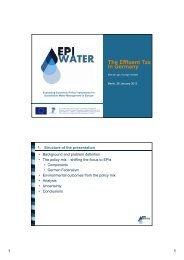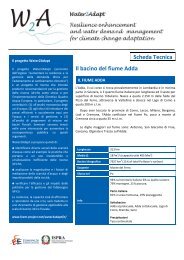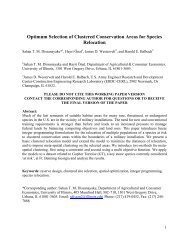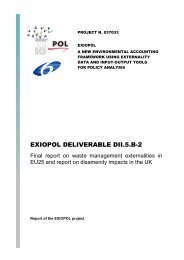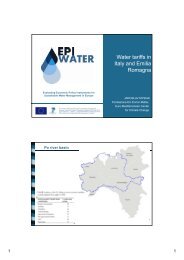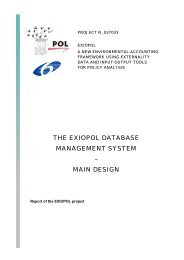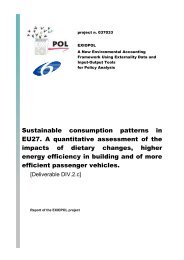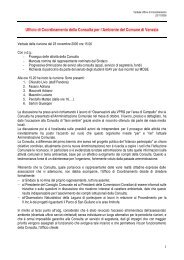Gulf and European Energy Supply Security - Feem-project.net
Gulf and European Energy Supply Security - Feem-project.net
Gulf and European Energy Supply Security - Feem-project.net
Create successful ePaper yourself
Turn your PDF publications into a flip-book with our unique Google optimized e-Paper software.
<strong>Energy</strong> <strong>Security</strong>: Potential for EU-GCC Cooperation<br />
holds a higher share of RES-E than the currently<br />
dominant large-scale hydro power. Additionally,<br />
wind offshore shows the strongest overall increase<br />
<strong>and</strong> amounts to 343 TWh/yr in 2030 so that wind<br />
energy in total already provides 40 percent of the<br />
overall RES-E generation. In contrast, novel RES-E<br />
options with huge future potentials such as PV (180<br />
TWh/yr), solar thermal electricity (126 TWh/yr) or<br />
tidal <strong>and</strong> wave energy (71 TWh/yr) enter the market<br />
<strong>and</strong> achieve a strong <strong>and</strong> steadily growing share. It<br />
is necessary to emphasize that this broad portfolio<br />
of different technologies, required in order to meet<br />
the 20 percent target in 2020, is only achieved when<br />
the existing non-economic barriers are overcome.<br />
As discussed in the electricity sector, the<br />
renewable heat sector also holds a big portfolio<br />
of different technologies in case of strengthened<br />
national policy measures. Although the biggest<br />
share of RES-H is still achieved in the individual,<br />
non-grid sector which is supplied by solid biomass,<br />
solar thermal heat <strong>and</strong> water as well as heat pumps<br />
about one quarter of the overall renewable heat is<br />
generated centrally <strong>and</strong> connected to distribution<br />
<strong>net</strong>works. In contrast, within the non-grid connected<br />
heat supply solid biomass generated about 50 Mtoe<br />
in 2006 <strong>and</strong> grows to 70 Mtoe in 2030, whereas<br />
novel technologies, holding hardly any share in<br />
2006, like heat pumps (29 Mtoe) <strong>and</strong> solar thermal<br />
104<br />
heat <strong>and</strong> water (26 Mtoe) show much bigger growth<br />
rates. Hence, the scenario predicts a decrease of<br />
the share of solid biomass within the non-grid heat<br />
sector from almost 100 percent now to below<br />
45 percent up to 2030. Nevertheless, biomass<br />
Figure 10: Future Renewable <strong>Energy</strong> Generation within the Electricity Sector in the <strong>European</strong><br />
Union up to 2030 on Technology Level according to the Global Regime Scenario<br />
t<br />
u<br />
p<br />
t<br />
u<br />
o<br />
y<br />
g<br />
r<br />
e<br />
n<br />
e<br />
-<br />
E<br />
-<br />
S<br />
E<br />
R<br />
]<br />
r<br />
a<br />
e<br />
y<br />
/<br />
h<br />
W<br />
T<br />
[<br />
2.500<br />
2.000<br />
1.500<br />
1.000<br />
500<br />
0<br />
2006 2010 2015 2020 2025 2030<br />
Wind offshore<br />
Wind onshore<br />
Tide & wave<br />
Solar thermal electricity<br />
Photovoltaics<br />
Hydro large-scale<br />
Hydro small-scale<br />
Geothermal electricity<br />
Biowaste<br />
Solid biomass<br />
Biogas<br />
plays a crucial role in the heat sector <strong>and</strong>, besides<br />
the individual heating plants, is also often used in<br />
co-firing plants. With respect to the overall target<br />
achievement of 20 percent RES by 2020, which is<br />
met under strengthened national policies, it must<br />
be concluded that strong efforts have to be put<br />
on the heat sector in order to achieve a doubling<br />
of renewables in the heat sector compared to<br />
the Business as Usual case. Figure 11 shows the<br />
development of RES-H on technology level.<br />
Figure 12 illustrates, according to the strengthened<br />
national policy scenario, the development of the<br />
renewables in the transport sector. Generally, the<br />
global CO2 constraints scenario results in a slightly<br />
higher transport fuel dem<strong>and</strong>. Hence, the overall<br />
RES-T generation contributes to 37.4 Mtoe, but the<br />
allocation of the three major contributors equals<br />
the Europe Alone scenario. Traditional biofuel<br />
generation triples beyond 2010 from 3.4 Mtoe as of<br />
2006 to 11.2 Mtoe by 2030. Additional contribution is<br />
expected from advanced biofuel generation (second<br />
generation – Fischer Tropsch, etc.) beyond 2020 up<br />
to 10 Mtoe in 2030. Generally, traditional biofuel




